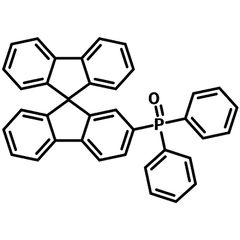SPPO1
CAS Number 1125547-88-7
High Purity Sublimed Materials, Semiconducting Molecules, TADF Materials
SPPO1, blue phosphorescent host
Host material for efficient host-to guest energy transfer in OLED devices
SPPO1, 9,9-Spirobifluoren-2-yl-diphenyl-phosphine oxide has a spirobifluorene structure with an electron deficient polar diphenyl-phosphine oxide moiety attached. The polarity in the P=O double bond can lead to a high triplet energy state, which is highly desirable in host materials for an efficient host-to guest energy transfer in an OLED.
SPPO1 can either be used as blue phosphorescent host or, due to its electron deficient nature, in OLED devices as an electron transport/hole blocking layer material. As a phosphorescent host, SPPO1 based blue PHOLEDs show much higher quantum efficiency than the well-known mCP based blue PHOLEDs.
General Information
| CAS number | 1125547-88-7 |
|---|---|
| Chemical formula | C37H25OP |
| Molecular weight | 516.57 g/mol |
| Absorption | λmax 317 nm (dichloromethane) |
| Photoluminescence | λem 347 nm (dichloromethane) |
| HOMO/LUMO | HOMO = 6.5 eV, LUMO = 2.8 eV; ET = 2.8 eV [1] |
| Chemical name | 9,9-Spirobifluoren-2-yl-diphenyl-phosphine oxide |
| Synonyms | 2-diphenylphosphine oxide-9,9'-spirobifluorene |
| Classification / Family | Phosphine oxide derivatives, Phosphorescent host materials, Electron transport materials, Hole blocking layer materials, Sublimed materials, Semiconducting small molecules |
Product Details
| Purity | Sublimed >99.0% (HPLC) |
|---|---|
| Melting point | Tg= 96°C (lit.) |
| Appearance | White powder/crystals |
*Sublimation is a technique used to obtain ultra pure-grade chemicals. For more details about sublimation, please refer to the sublimed materials.
Chemical Structure

Device Structure(s)
| Device structure | ITO (70 nm)/TAPC (50 nm)/TCTA:FIrPic (7%, 10 nm)/TCTA:RD(7%, 0.5 nm)/TCTA:Ir(chppy)3 (7% 1.5 nm)/SPPO1:FIrPic (10%, 10 nm)/Tm3PyPB (20 nm)/Tm3PyPB:Cs (30 nm)/LiF (1 nm)/Al (120 nm) [2] |
|---|---|
| Colour |
|
| Max. EQE | 19% |
| Max. Power Efficiency | 54.0 Im/W |
| Device structure | ITO/TCTA (50 nm)/SPPO1:FIrPic (50 nm, 10%)/LiF/Al [3] |
|---|---|
| Colour |
|
| Max. Luminance | 7,108 cd/m2 |
| Max. EQE | 12.3% |
| Device structure | ITO/TCTA:(btc)2(acac)Ir (50 nm, 7%)/SPPO1 (50 nm)/LiF/Al [3] |
|---|---|
| Colour |
|
| Max. Luminance | 16,410 cd/m2 |
| Max. EQE | 10.6% |
| Device structure | ITO/TCTA:(btc)2(acac)Ir (50 nm, 7%)/SPPO1:FIrPic (50 nm, 10%)/LiF/Al [3] |
|---|---|
| Colour |
|
| Max. Luminance | 18,330cd/m2 |
| Max. EQE | 12.9% |
| Max. Current Efficiency | 30.3 cd/A |
| Max. Power Efficiency | 30.0 lm/W |
Pricing
| Grade | Order Code | Quantity | Price |
|---|---|---|---|
| Sublimed (>99.0% purity) | M2292A1 | 250 mg | £300 |
| Sublimed (>99.0% purity) | M2292A1 | 500 mg | £560 |
| Sublimed (>99.0% purity) | M2292A1 | 1 g | £1000 |
MSDS Documentation
Literature and Reviews
- A high triplet energy phosphine oxide derivative as a host and exciton blocking material for blue phosphorescent organic light-emitting diodes,S. Jeon et al., Thin Solid Films, 518 (14), 3716-3720 (2010); DOI: 10.1016/j.tsf.2009.10.012.
- Efficient white phosphorescent organic light‐emitting diodes for solid‐state lighting applications using an exciton‐confining emissive‐layer structure, J. Lee et al., J. Infor. Display, 10 (2), 92-95 (2009); DOI: 10.1080/15980316.2009.9652088.
- Simplified Bilayer White Phosphorescent Organic Light-Emitting Diodes, J. Lee et al., ETRI J. 38 (2); 260-264 (2016); DOI: 10.4218/etrij.16.2515.0011.

 SPPO1 MSDS sheet
SPPO1 MSDS sheet